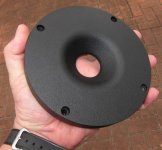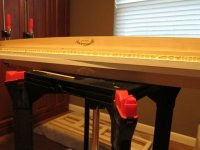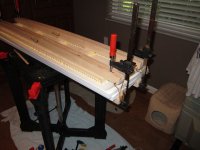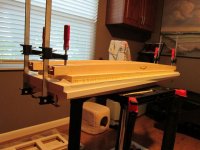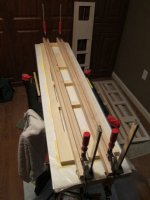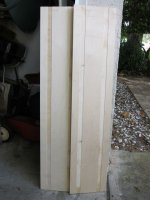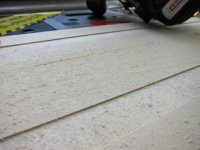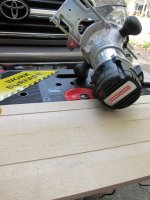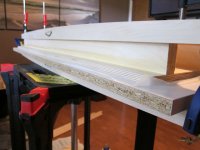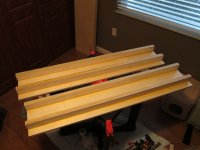The Elsinores have plenty of bass down to about 38 to 40 hz, or the low string on a 4 string bass. I tuned my port at 33 hz so there is useable bass down to theere. I use a sub, set at the lowest crossover point, 40 hz, to augment the last octave. On most music it isn't necessary. The speakers are not boomy so a bass head probably won't be satisfied with out a sub. I use a variable phase sub amp and it integrates well with the Elsinores.
Question on your tapping the waveguides. What was the reason you decided to tap completely through the guide? No enough material or just thought there would be added benefit and strength by tapping completely though the guide?
Most of the guides in the picture are just tapped at the back so you can decide which way to use it. Bottoming tap used so its threaded close to the face.
I have three that go through the front. I prefer to make them this way because there is a bit more play to perfectly center the dome and easier to mount the tweeter as the bolts are inserted through the guide and spacers placed around the bolts but if decided not to mount the tweeter this way then theres four holes showing..
If mounting the tweeter to the waveguide was the standard I would havethe waveguides made so the tweeter faceplate rests over Aluminum(more land at the back) and spacers would not be needed. With this, Mounting the tweeter to the subfront would not be possible.
bass head
My first thought is that Elsinores are not bass head speakers but have many examples of rcordings with a ton of low bass and this comes through. Same for upper Bass
My room is well controlled with 20 Bass Traps and traps built in to bulk head so Bass isn't boomy and output varies with every recording.. I can sit at the back wall where theres a build up and the bass is heavy there but coloured.
I heard the Edgarhorn Seismic Sub. Now there's a Bass Head Sub and very smooth and relaxed with massive output. No idea how to place and integrate it.
I feel the Elsinore is aTop Quality Studio Monitor but in a Beautiful way. This includes the Bass characteristics..
if the Elsinore were a drink, with its sound balance ~ what would it be?
That's a very good question.
I won't try to answer it, but I wouldn't mind hearing other's opinions.
Cheers, Joe R.
Hi Joel
Received the Waveguides today, beautiful work.
To others, I can certainly recommend them. You really have to see them to appreciate what Joel has done and also pay him for his efforts. They are also surprisingly heavy when you feel them in your hand. I saw how much the postage to Australia was.
Also, the Waveguide has been designed so that the HDS tweeter can be mounted first to the Waveguide and then into the box. This is a definite plus as it adds mass at a very useful place.
Cheers, Joe R.
Received the Waveguides today, beautiful work.
To others, I can certainly recommend them. You really have to see them to appreciate what Joel has done and also pay him for his efforts. They are also surprisingly heavy when you feel them in your hand. I saw how much the postage to Australia was.
Also, the Waveguide has been designed so that the HDS tweeter can be mounted first to the Waveguide and then into the box. This is a definite plus as it adds mass at a very useful place.
Cheers, Joe R.
Attachments
Last edited:
A friend and I did some measurements on my build of the Elsinores Mark 5. I thought I would pass on a couple of comments that might be helpful to others. I built my own wave guide. When we did our measurements on the tweeter there was a sharp dip around 2K. My waveguide was about 1mm away from the tweeter. When I used some modeling clay to fill in the gap, the dip went away. The whole character of the speakers changed. I listened to them for a few days and really didn't like the way it sounded nearly as well. There was much more space information with the gap and the slight amound of glare was gone. The 1.8uF cap takes some of the glare away but at the cost of about 1/2 db output. I ended up using the 2.0uF. If you are using the Joel wave guide try putting a thin washer between the tweeter and the guide when you mount it to the guide and that should let you hear what I am talking about.
Also, I had tried several lengths of 3" pvc couplings to test the bass. I cut the hole with a hole guide so the fit was very tight. When we made bass measurements there were some erratic anomalies. My friend suggested using duct tape to completely seal the tube to the port. Fixed the problem and let us tune the port to 33hz. After we found the right length I secured and sealed the port tube. The bass got more coherent and lower. Hope this helps.
Also, I had tried several lengths of 3" pvc couplings to test the bass. I cut the hole with a hole guide so the fit was very tight. When we made bass measurements there were some erratic anomalies. My friend suggested using duct tape to completely seal the tube to the port. Fixed the problem and let us tune the port to 33hz. After we found the right length I secured and sealed the port tube. The bass got more coherent and lower. Hope this helps.
...Also, I had tried several lengths of 3" pvc couplings to test the bass. I cut the hole with a hole guide so the fit was very tight. When we made bass measurements there were some erratic anomalies. My friend suggested using duct tape to completely seal the tube to the port. Fixed the problem and let us tune the port to 33hz. After we found the right length I secured and sealed the port tube. The bass got more coherent and lower. Hope this helps.
The glue of most duct tape deteriorates fairly rapidly. You may want to consider roof flashing tape which is designed to last decades.
Regards
Warren in Sydney
A friend and I did some measurements on my build of the Elsinores Mark 5. I thought I would pass on a couple of comments that might be helpful to others. I built my own wave guide. When we did our measurements on the tweeter there was a sharp dip around 2K. My waveguide was about 1mm away from the tweeter. When I used some modeling clay to fill in the gap, the dip went away. The whole character of the speakers changed. I listened to them for a few days and really didn't like the way it sounded nearly as well. There was much more space information with the gap and the slight amound of glare was gone. The 1.8uF cap takes some of the glare away but at the cost of about 1/2 db output. I ended up using the 2.0uF. If you are using the Joel wave guide try putting a thin washer between the tweeter and the guide when you mount it to the guide and that should let you hear what I am talking about.
I guess my question here is more for Joel. Joel, with your waveguide, is there a gap between the tweeter front plate and the back of the waveguide? Is so, how much of a gap and why?
I guess I do not understand the rationale for a gap (even if the resulting dip in frequency response is audibly pleasing).
The gap causes a mechanical dip in the tweeters respose essentially removing the tweeter from the audible output below about 2K without using electrical components. The midrange/woofers are the dominate speakers at 2K. I think the tweeters must be a little rough that low, the fact the signal is out of phase and our natural tendency to be sensitive to those frequencies (Got to do with the length of wave and how wide our heads are) all combines to make this tweek work. I have always been one that judges my system by how it sounds. If something sounds better I use it. In my set up the music is much more involving and the emotion is conveyed better with the gap, so I use it. I have some o-rings that are just the right size to fill the gap and I occasionally slip them in for a comparison but I usually don't get through a whole cd. I will probably get some of Joel's guides to see if this holds true with them. Do you still have a pair available Joel?
I guess my question here is more for Joel. Joel, with your waveguide, is there a gap between the tweeter front plate and the back of the waveguide? Is so, how much of a gap and why?
The gap is small. I wanted the tweeter faceplate mounting area to make contact with waveguide back before contact is made at the concave around the dome. I'd guess the gap is around . 2mm.
As for the treble sound: It's very revealing and detailed and shows a huge range in the quantity and quality or style of treble from recordings.. ie Patricia Barber on MFSL is delicate and Flaming Lips industrial treble is harsh and more tip up. MkIV treble didn't swing as much. I can see some care is needed in getting it to taste. Running basic 2.uf and cheap 3ohm and enjoying the sound so much that changing dosen't feel urgent but want to try 1.8 and and realy good resistor to average out the treble more..
Tapte, I only have and odd(1 with through hole mounting, 1 without) pair left from the last batch.. I'm getting more made and it should be about month.
Since youre putting time into the tweaks I would glady part with the pair out of mine and I can use the odd pair- up to you.
HAMLET UPGRADE POSSIBILITIES
Spoonted, here on this site is interested in building the Hamlet Cabinets. He's in Australia and could get them to Joe.
I will supply the waveguides shipped to spoonted.
If others could get together and pay for the drivers would could get a MKV Hamlet.... If joe can do it
A recent experience and fun Too. Also plug for Elsinore
I attended the Toronto Audio Video Entertainment Show on the weekend and listened many systems. Its amazing how different sounding every one is. My favorite was a speaker that was work in progress and not for sale yet.. It contained Accuton drivers.. The sound was very tactile and open.
several peaople in the chairs were glued down with eyes closed..
starting price is $72k for the pair when ready.. Mind you the amps were large mono tubes so not sure how much of that I was hearing..
Enjoyed several single driver systems especially Tannoy..
The Elsinore easily competes in that arena and surpases most..
Joel, I would like a pair that has the mounting holes for the tweeter, if that is possible, that way I can be certain of the gap between the wave guide and tweeter. I have access to some pro testing gear and I could show the differences the size of the gap makes. Do you take pay pal?
Joel, I would like a pair that has the mounting holes for the tweeter, if that is possible, that way I can be certain of the gap between the wave guide and tweeter. I have access to some pro testing gear and I could show the differences the size of the gap makes. Do you take pay pal?
The pair I have in place has tweeter mounted to the back. I used 6/32 threads on that pair. If you can please email me.
HAMLET UPGRADE POSSIBILITIES
If others could get together and pay for the drivers would could get a MKV Hamlet.... If joe can do it
I'm in. Anyone else?
HAMLET UPGRADE POSSIBILITIES
Spoonted, here on this site is interested in building the Hamlet Cabinets. He's in Australia and could get them to Joe.
I will supply the waveguides shipped to spoonted.
If others could get together and pay for the drivers would could get a MKV Hamlet.... If joe can do it
A recent experience and fun Too. Also plug for Elsinore
I attended the Toronto Audio Video Entertainment Show on the weekend and listened many systems. Its amazing how different sounding every one is. My favorite was a speaker that was work in progress and not for sale yet.. It contained Accuton drivers.. The sound was very tactile and open.
several peaople in the chairs were glued down with eyes closed..
starting price is $72k for the pair when ready.. Mind you the amps were large mono tubes so not sure how much of that I was hearing..
Enjoyed several single driver systems especially Tannoy..
The Elsinore easily competes in that arena and surpases most..
Just to put a bit more light on the subject, the hamlets will stay with Joe as a small token of appreciation for the amount of work that will be involved for designing crossovers etc.
If there is anyone in Australia who is capable of veneering and would like to help out can they give me a pm please.
Cheers Spoonted
Let the gluing begin!
Finally got some time to start gluing together the sub panels and braces.
Decided to go in a somewhat different direction with the clamping method. I picked up some bowclamps. They are precision manufactured cauls that work really well with long pieces such as these panels. Once you get used to them, they make short work out of the clamping process.
Through a bit of trial and error, I found the caul-sandwich worked best less you induce bowing into the final product. If you have a nice heavy duty table surface to clamp against, you could probably get away with two less bowclamps.
Finally got some time to start gluing together the sub panels and braces.
Decided to go in a somewhat different direction with the clamping method. I picked up some bowclamps. They are precision manufactured cauls that work really well with long pieces such as these panels. Once you get used to them, they make short work out of the clamping process.
Through a bit of trial and error, I found the caul-sandwich worked best less you induce bowing into the final product. If you have a nice heavy duty table surface to clamp against, you could probably get away with two less bowclamps.
Last edited:
Back Panel assembly
After looking at Joel's handiwork, I decided to over-size my cuts by a few millimeters in order to use a shallow through dado to ease assembly (thanks Joel!!).
By shallow, I mean the depth of a single ply. This really worked well as nothing moved around during the glue up. Broke out the bowclamps again for the actual gluing.
I am going to use this technique again on the main side panels. Main cabinet gluing starts tomorrow.
After looking at Joel's handiwork, I decided to over-size my cuts by a few millimeters in order to use a shallow through dado to ease assembly (thanks Joel!!).
By shallow, I mean the depth of a single ply. This really worked well as nothing moved around during the glue up. Broke out the bowclamps again for the actual gluing.
I am going to use this technique again on the main side panels. Main cabinet gluing starts tomorrow.
Attachments
A friend and I did some measurements on my build of the Elsinores Mark 5. I thought I would pass on a couple of comments that might be helpful to others. I built my own wave guide. When we did our measurements on the tweeter there was a sharp dip around 2K. My waveguide was about 1mm away from the tweeter. When I used some modeling clay to fill in the gap, the dip went away... If you are using the Joel wave guide try putting a thin washer between the tweeter and the guide when you mount it to the guide and that should let you hear what I am talking about.
Thanks Terry
Some belated comment....
It won't be long before the word is out that we are doing some commercial models based, at least in some part and related to, the experience gained with the development of the Elsinores.
Indeed the Waveguide does benefit from a more, what can I call it, a snug fit in the throat part. The commercial Waveguide will also be based on 150mm aluminium - but the manufacturer has gone to great length - but one that DIY guys would find difficult the match. So Steve and I came up with something that was easy to put on paper and had some 'latitude' in the throat part. So experimentation filling in any gap there is certainly not discouraged.
Other comments...
This is a little tricky, so I use my words carefully. Let me make the point bluntly that a speaker design is basically a series of what may be deemed as acceptable compromises, and this applies to any intelligently (as opposed to just plain luck) speaker design.
Parallel networks relative to the Voice Coils are avoided in the latest Elsinore Mk5 design. All I can say at this stage is there are reasons for that. The near future and cutting edge of dynamic (speakers with coils and magnetic circuits) is the reduction in phase noise. That term applies to the frequency domain, but another name it is known by is, when it is described in its equivalent term is the time domain and... almost any audiophile will recognise the word jitter!
This will in the near future be the cutting edge in speaker design, of this I am quite sure. Indeed one leading (and very expensive) loudspeaker brand's new models are spruiked as using ant-jitter crossovers (but we detect that the technique they use is rather crude).
So this means that a different set of compromises are being imposed that would otherwise be the case.
For those who wish to measure (and indeed also listen) should realise that the best performance comes from a listening distance of at least two metres and approximate 15 degrees off axis. Hence set up the speakers reasonable well apart and hopefully no closer that 50cm from the rear wall. Aim the speakers towards the listener but no more than the listener can see the inside wall.
From here you can experiment with the width of the placement and also if you wish, the degree of toe-in towards the listener.
What is clear is that, if the speaker is pointed directly towards the listener (both of them of course) then expect there to be an excess of energy centered around 4KHz. Toeing out will lessen that lift and if you wish to experiment with that, it is definitely suggested that you do. The final amount of toe-in could well dependent of the inherent brightness of your system and if it is biased that way tonally, you may even find point the speaker straight down the line of the room (but no more) as preferable. But I suggest that in a well-balanced system there will always be some toe-in.
The width of the placement of the speakers can also be dependent on the overall performance of the system. In fact with a really excellent system, they can often be spread a little further apart than you thought possible. But again I shall impose no strict rule other than try it. Speaker placement should never just be taken fro granted.
Cheers, Joe R.
Just to put a bit more light on the subject, the hamlets will stay with Joe as a small token of appreciation for the amount of work that will be involved for designing crossovers etc.
If there is anyone in Australia who is capable of veneering and would like to help out can they give me a pm please.
Cheers Spoonted
No problem. I am only asking for the cabinets.
Cheers, Joe R.
- Home
- Loudspeakers
- Multi-Way
- The "Elsinore Project" Thread
